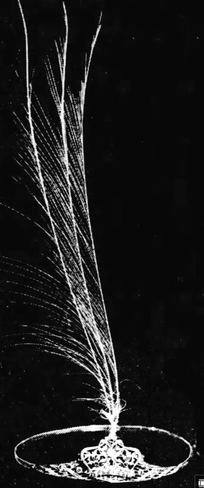Diadem
==Diadem ==
A diadem is a type of crown, specifically an ornamental headband worn by monarchs and others as a symbol of sovereignty. The term originates from the Greek word "διάδημα" (diádēma), meaning "band" or "fillet". Diadems have been used throughout history in various cultures and are often associated with royalty and high status.
History[edit | edit source]
Ancient Civilizations[edit | edit source]
In ancient Egypt, diadems were worn by pharaohs and were often adorned with symbols such as the uraeus, a representation of a rearing cobra, which was believed to protect the wearer. The Persian Empire also utilized diadems, with the Achaemenid kings wearing elaborate headbands as a sign of their authority.
In Ancient Greece, diadems were worn by both men and women of high status. They were often made of precious metals and decorated with intricate designs. The Hellenistic period saw the use of more elaborate diadems, often encrusted with jewels.
Roman Empire[edit | edit source]
During the Roman Empire, diadems were adopted by emperors as a symbol of their divine right to rule. The emperors wore diadems made of gold and adorned with precious stones. The use of diadems continued into the Byzantine Empire, where they became even more elaborate and were often depicted in Byzantine art.
Medieval and Renaissance Europe[edit | edit source]
In medieval Europe, diadems were worn by kings and queens as part of their regalia. They were often used in coronation ceremonies and other state occasions. During the Renaissance, diadems became more ornate, reflecting the period's emphasis on art and beauty.
Types of Diadems[edit | edit source]
Diadems can vary greatly in design and complexity. Some common types include:
- Fillet Diadem: A simple band, often made of metal or cloth, worn around the head.
- Jeweled Diadem: A more elaborate headband, often encrusted with precious stones and metals.
- Coronet: A small crown, often worn by nobility, that can be considered a type of diadem.
Cultural Significance[edit | edit source]
Diadems have held significant cultural and symbolic meaning throughout history. They are often associated with:
- Royalty and Nobility: Diadems are a common symbol of royal and noble status.
- Religious Significance: In some cultures, diadems are used in religious ceremonies and are believed to have protective or divine properties.
- Fashion and Beauty: In addition to their symbolic meanings, diadems have also been worn as decorative accessories, particularly in the context of fashion and beauty.
Modern Usage[edit | edit source]
Today, diadems are still used in various ceremonial contexts. They are often seen in beauty pageants, where they are awarded to winners as a symbol of their title. Diadems are also used in some modern monarchies during coronation ceremonies and other state events.
See Also[edit | edit source]
References[edit | edit source]
External Links[edit | edit source]
Navigation: Wellness - Encyclopedia - Health topics - Disease Index - Drugs - World Directory - Gray's Anatomy - Keto diet - Recipes
Search WikiMD
Ad.Tired of being Overweight? Try W8MD's physician weight loss program.
Semaglutide (Ozempic / Wegovy and Tirzepatide (Mounjaro / Zepbound) available.
Advertise on WikiMD
WikiMD is not a substitute for professional medical advice. See full disclaimer.
Credits:Most images are courtesy of Wikimedia commons, and templates Wikipedia, licensed under CC BY SA or similar.Contributors: Prab R. Tumpati, MD





